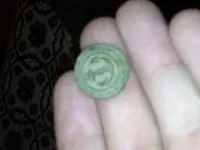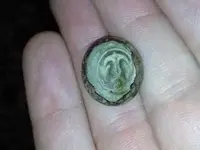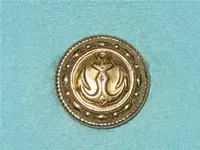Your button is 2 piece, iron back. Without a backmark the best we can do is date it no older than mid 19th century. Im sure someone will correct me if Im wrong but 2 piece buttons were not around any earlier. Tinned ironbacks were made CW era as well as the 20th century.
CC Hunter says its 20th century because its thin and rusted away. I wouldnt have been able to tell.
The button is most definitely 20th century based on all the contributing factors. As I recall, my words were "based on the die-work AND thin steel back".

Now, I must correct the assumption that two-piece buttons will date no earlier than mid 19th century.

There were brass two-piece buttons being made by U.S. companies as early as the 1830's or so. During the Rev War, thin brass buttons (almost foil like), were made "two-piece" over a bone back, by British, American, and French manufactures. Furthermore, some of the earliest examples of brass buttons are the solder seamed two-piece, and vent-hole two piece, that pre-date the popular "flat buttons" generally seeing widespread use from 1760-1860.

Now on to steel back buttons. It is a fact that during the time period slightly before, during, as well after, the American Civil War, some two piece buttons were made with a tinned steel back. However, this was the exception rather than the rule. Additionally, these "tinned" steel backs were very well constructed and in most instances hold up nearly as well as the rolled brass die-stamped button face, in most all ground conditions. 19th century tinned steel was high quality material. Tin was applied very liberally and being a lovely shiny non-ferrous metal, protected the steel quite well from corrosion. As a testament to 19th tinned steel quality, I have a number of excavated tinned items, that are still as shiny as the chrome on a brand new a '57 Cadillac. As with all things, quality soon gives way to cheaper production techniques, and by the 20th century tinned steel backs give way to inferior painted or thin plated steel back on buttons. Die-work is another point to consider. With high quality military buttons on the 19th century, there seems to be a different look with a "crispness" to the details. This is due to the type and quality of brass (usually top notch from "Brass City" USA*), as well as thickness of material, quality of the die, amount of machinery pressure, etc., etc.. With cheaper quality manufacturing, we do not see the same type of product (the same holds true for the China cr@p we are forced to buy as tools now).
CC Hunter
*Research that one








 There were brass two-piece buttons being made by U.S. companies as early as the 1830's or so. During the Rev War, thin brass buttons (almost foil like), were made "two-piece" over a bone back, by British, American, and French manufactures. Furthermore, some of the earliest examples of brass buttons are the solder seamed two-piece, and vent-hole two piece, that pre-date the popular "flat buttons" generally seeing widespread use from 1760-1860.
There were brass two-piece buttons being made by U.S. companies as early as the 1830's or so. During the Rev War, thin brass buttons (almost foil like), were made "two-piece" over a bone back, by British, American, and French manufactures. Furthermore, some of the earliest examples of brass buttons are the solder seamed two-piece, and vent-hole two piece, that pre-date the popular "flat buttons" generally seeing widespread use from 1760-1860. 

 Looking forward to seeing a few pictures of these colonial 2 piece buttons that may be mistaken for mid 19th century 2 piece, merely because I am not familiar with them and willing to learn.
Looking forward to seeing a few pictures of these colonial 2 piece buttons that may be mistaken for mid 19th century 2 piece, merely because I am not familiar with them and willing to learn.  Why else would I be here?
Why else would I be here? 

 I thought for sure I had seen some CW era Naval hat buttons with rusted out backs. My computer is driving me carazy it keeps shutting down and I am constantly editting Im through here
I thought for sure I had seen some CW era Naval hat buttons with rusted out backs. My computer is driving me carazy it keeps shutting down and I am constantly editting Im through here